The best wildlife-friendly permaculture fencing solutions include living hedgerows that create habitat corridors, wattle fencing from sustainably coppiced materials, strategic stone walls with wildlife passages, wildlife-friendly electric fencing at appropriate heights, permeable wooden designs with animal access points, edible berry fences, and layered plant guilds as protective boundaries. You’ll create more resilient ecosystems while maintaining effective boundaries between spaces, protecting your gardens without isolating them from the surrounding environment.
Living Hedgerows: Native Plant Barriers for Wildlife Corridors
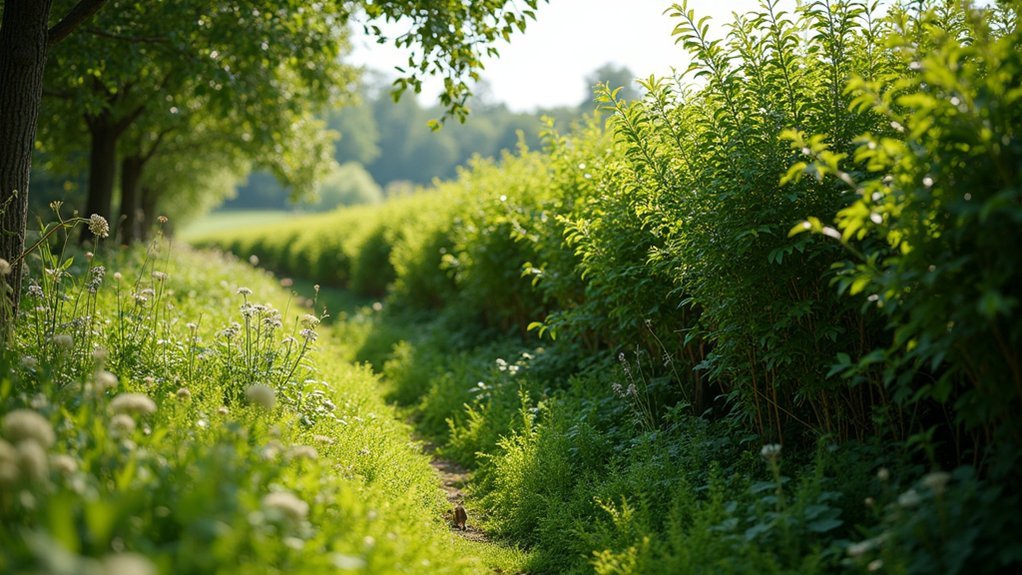
While conventional fencing materials like metal and wood create rigid boundaries on your property, living hedgerows offer a dynamic alternative that supports local ecosystems.
These diverse native plant assemblages serve as wildlife corridors, allowing animals to navigate safely between fragmented habitats while avoiding dangerous roadways.
You’ll enhance biodiversity as your living hedgerow provides essential habitat and food sources for pollinators and beneficial insects. The deep root systems improve soil health by preventing erosion and enhancing nutrient cycling throughout your permaculture landscape.
Beyond ecological benefits, these natural boundaries function as windbreaks and noise buffers.
Wattle Fencing From Sustainable Coppiced Materials
Wattle fencing offers you a genuinely eco-friendly barrier option by using flexible branches from sustainably coppiced woods like hazel, willow, and sweet chestnut that regrow after harvesting.
You’ll find installation straightforward and chemical-free, requiring only fresh-cut saplings woven between sturdy stakes driven into the ground without preservatives or treatments.
Sourcing Appropriate Woods
How can you create boundaries that serve both your land and local wildlife? Wattle fencing from coppiced materials offers an ecological solution that supports biodiversity while creating effective permaculture boundaries.
When sourcing woods for your fence, prioritize local, sustainable options that promote wildlife movement and ecological integration:
| Wood Type | Coppicing Cycle | Best Features |
|---|---|---|
| Willow | 1-2 years | Flexible, fast-growing, roots easily |
| Hazel | 7-9 years | Strong, durable, wildlife-friendly |
| Maple | 8-10 years | Resilient, attractive bark, bird habitat |
| Sweet Chestnut | 15-20 years | Long-lasting, rot-resistant, insect haven |
| Alder | 5-7 years | Wet-tolerant, nitrogen-fixing, amphibian support |
Choose species that regrow vigorously after cutting and match your climate conditions. These sustainable materials create permeable boundaries that allow small creatures to pass while defining your garden spaces.
Installation Without Chemicals
Creating wattle fencing without chemical treatments preserves both ecological integrity and natural aesthetics in your permaculture design.
You’ll find this environmentally friendly method requires just sustainably coppiced branches and wooden stakes—no preservatives or toxic compounds needed.
When installing your wattle fence, drive stakes firmly into the ground at 2-3 foot intervals, then weave flexible branches horizontally between them.
These living fences offer immediate wildlife benefits as they mature in your garden. The woven structure creates micro-habitats for beneficial insects and small animals while simultaneously functioning as effective boundaries.
For best results, use freshly cut branches that still maintain flexibility.
As your permaculture garden evolves, you’ll appreciate how these natural barriers decompose gradually, returning nutrients to the soil while continuing to serve their primary purpose.
Wildlife Passage Design
While establishing boundaries in your permaculture garden, you’ll need to balance protection with ecological connectivity. Wattle fencing offers an ideal solution by weaving flexible coppiced branches into natural barriers that maintain critical wildlife corridors.
Unlike solid barriers, these permeable structures allow small animals and insects to move freely through your landscape.
You’ll appreciate the aesthetic appeal of wattle fencing as it blends harmoniously with your permaculture designs. By using sustainable materials from local coppiced trees, you’re supporting ecosystem health through reduced transportation emissions and enhanced soil quality.
The coppicing process actually stimulates regrowth, creating a renewable resource cycle.
When properly installed, wattle fencing creates effective boundaries while supporting local wildlife populations. This traditional technique embodies permaculture principles by working with nature rather than against it—providing protection without ecological isolation.
Strategic Stone Walls With Wildlife Passages
Strategic stone walls can transform your permaculture space with intentionally designed wildlife passages that allow smaller animals like rabbits and foxes to move freely through 12-16 inch openings.
You’ll notice these structures create valuable thermal microclimates, absorbing heat during the day and slowly releasing it at night, which extends your growing season for nearby plants.
The temperature regulation provided by stone walls also creates diverse habitat niches, supporting beneficial insects and small vertebrates that contribute to your garden’s ecological balance.
Wildlife Crossing Designs
When designing stone walls for your permaculture property, incorporating dedicated wildlife passages transforms a potential barrier into a wildlife-friendly boundary.
Position these openings at regular intervals, particularly in high-traffic wildlife areas, to maintain ecological connectivity and natural animal migration patterns.
Make your passages at least 12 inches high and 18 inches wide to accommodate various species. This simple modification greatly reduces wildlife-vehicle collisions while supporting habitat protection goals.
Enhance effectiveness by planting native vegetation around crossing points—these natural guides direct animals toward safe passage routes.
Consider installing trail cameras for monitoring usage of your wildlife corridors. The data you’ll collect provides valuable insights into crossing effectiveness and helps you refine your permaculture fencing strategy over time, ensuring your property supports rather than hinders local wildlife movement.
Thermal Microclimate Benefits
Beyond their wildlife protection features, stone walls with integrated passages create valuable thermal microclimates throughout your permaculture landscape.
These strategic structures absorb heat during daylight hours and gradually release it overnight, protecting sensitive plants from harmful temperature fluctuations while extending your growing season.
The solid mass of properly designed stone walls provides excellent wind protection, creating sheltered zones where diverse plant growth can flourish.
When you incorporate wildlife passages, you’re building a system that enhances ecosystem resilience while increasing biodiversity.
- Feel the satisfaction as tender plants thrive against your stone wall when neighboring gardens struggle with frost damage
- Experience the wonder of watching wildlife move freely through your property while benefiting from your thoughtful design
- Enjoy the abundance that comes from longer growing seasons and increased habitat connectivity
Wildlife-Friendly Electric Fencing Techniques

Electric fencing offers permaculture practitioners a flexible solution that balances wildlife protection with effective property boundaries.
When implementing a wildlife-friendly approach, use lower voltage systems (3,000-4,000 volts) with pulsing currents that deter predators without causing harm to animals that accidentally contact the fence.
Install your electric fence at 40-42 inches high, with bottom wires positioned at least 16 inches above ground to allow young animals to pass underneath safely.
Maintain vertical wire spacing of 16 inches to prevent entrapment while still creating an effective barrier.
Enhance your electric fencing by incorporating natural barriers and vegetation around the perimeter.
These additions not only help blend the fence into your landscape but also provide additional habitat for beneficial wildlife while reinforcing the boundary’s effectiveness.
Permeable Wooden Fence Designs With Animal Access Points
Permeable wooden fences offer a natural alternative to electric systems while maintaining wildlife-friendly boundaries.
By incorporating 16-inch spaced horizontal rails and strategically designed gaps, you’ll create pathways for small mammals like rabbits and hedgehogs while still containing livestock.
These thoughtful designs support local ecosystem health and movement corridors essential for biodiversity.
- Create living habitats – Line fence bases with native flowering plants to attract pollinators and provide shelter, transforming your boundary into a thriving wildlife sanctuary.
- Build with untreated wood – Embrace sustainability by choosing natural materials that decompose harmlessly when their lifecycle ends.
- Design multi-functional access points – Position animal passages at natural wildlife corridors to connect fragmented habitats, giving creatures safe routes through your property.
Edible Berry Fences That Benefit Animals and Humans
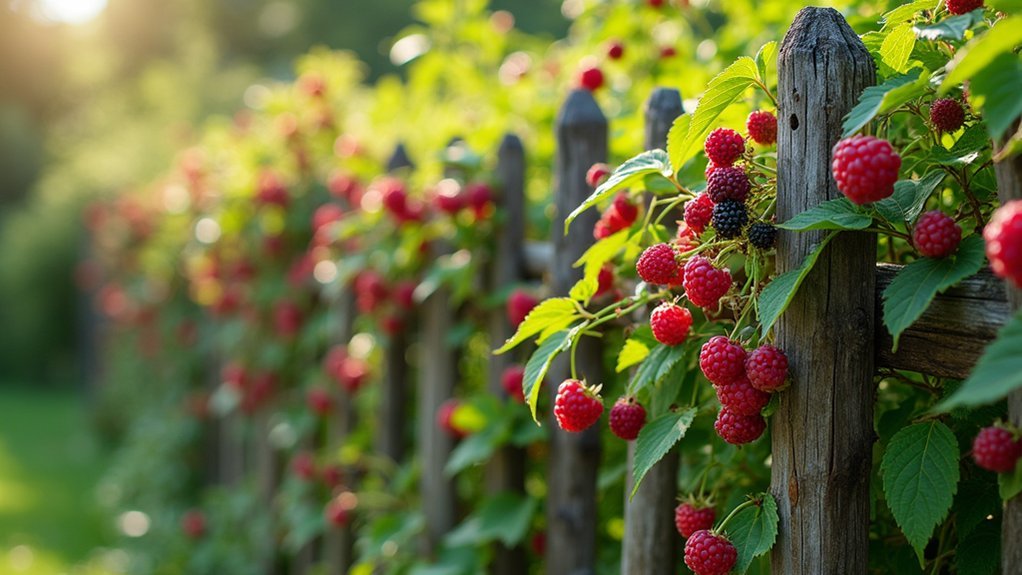
While traditional fencing focuses primarily on exclusion, edible berry fences transform boundaries into productive, living ecosystems that nourish both people and wildlife.
You’ll create a multifunctional barrier by planting blackberries, raspberries, and blueberries that deter larger animals while providing habitat and forage for smaller creatures.
These living fences contribute to soil health as fallen fruit and plant matter decompose, feeding beneficial microorganisms.
By selecting various berry species that ripen at different times, you’ll enjoy a continuous harvest throughout the growing season.
Beyond food production, edible berry fences attract pollinators and beneficial insects that support your entire garden system.
They also serve as effective windbreaks and microclimates, protecting sensitive plants while enhancing biodiversity.
This permaculture approach creates boundaries that aren’t just barriers but productive elements within your sustainable landscape.
Layered Plant Guilds as Protective Boundaries
Creating strategic layers of diverse plants offers a sophisticated approach to natural fencing that goes beyond simple barriers. By establishing layered plant guilds with varying heights, you’ll create protective boundaries that serve multiple functions in your permaculture design.
These wildlife-friendly barriers provide habitat and food while effectively managing access to your cultivated areas.
- Connect with abundance – Incorporate edible plants throughout your guild, harvesting berries, nuts, and herbs while wildlife enjoys their share.
- Foster resilience – Watch as your diverse mix of native species attracts beneficial insects, strengthening your garden’s ecosystem.
- Experience harmony – Feel the satisfaction of creating sustainable permaculture boundaries that protect your garden while supporting local wildlife.
Your layered guild will work with nature, not against it, providing protection and productivity simultaneously.
Frequently Asked Questions
What Is the Best Fence to Keep Wild Animals Out?
You’ll find exclusion fencing works best, ideally 6-8 feet high with 16-inch vertical wire spacing. Electric fencing offers a lightweight alternative, while woven wire provides cost-effective strength. Consider wildlife-friendly designs with elevated bottom wires.
How to Build a Critter Proof Garden Fence?
To build a critter-proof garden fence, you’ll need 6-8 foot high barriers with 16-inch vertical wire spacing. Use smooth bottom wires 16 inches above ground and consider adding electric fencing for enhanced protection against persistent predators.
What Is Wildlife Friendly Fencing?
Wildlife-friendly fencing allows you to protect your property while ensuring animals can move safely across landscapes. You’ll use wider wire spacing, adequate bottom clearance, and appropriate heights that don’t entangle or block wildlife migration patterns.
What Fencing Is Nature Friendly?
Nature-friendly fencing includes living hedges, smooth wire designs with 16-inch spacing, 40-inch height limits, and wooden top rails. You’ll find these solutions allow wildlife to pass safely while still protecting your property.
In Summary
By choosing any of these seven wildlife-friendly fencing solutions, you’re creating boundaries that work with nature rather than against it. You’ll protect your permaculture space while allowing beneficial creatures to move freely through the landscape. Remember, good fences don’t just make good neighbors—they create thriving ecosystems where you, your plants, and local wildlife can all flourish together in a balanced permaculture system.

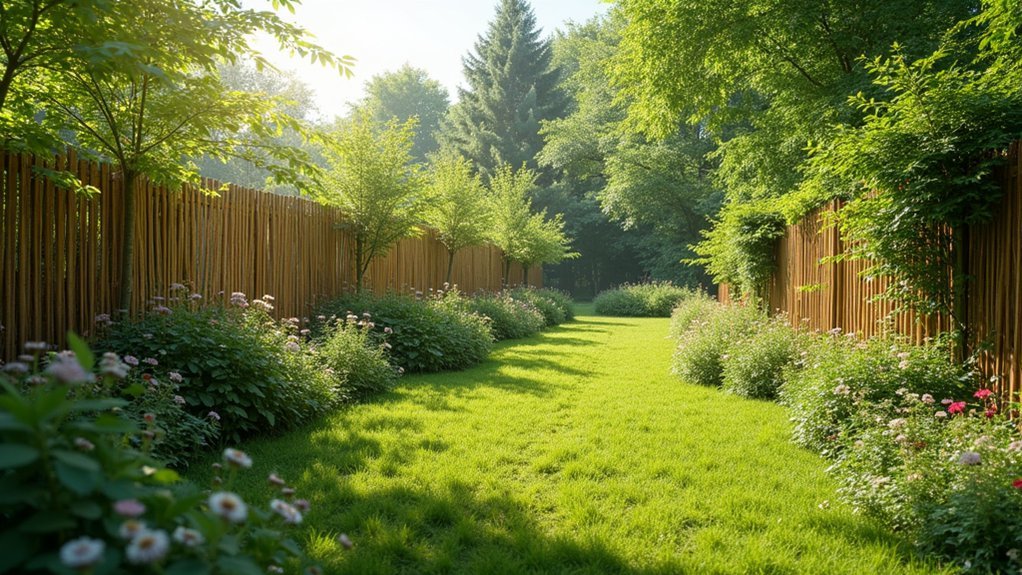

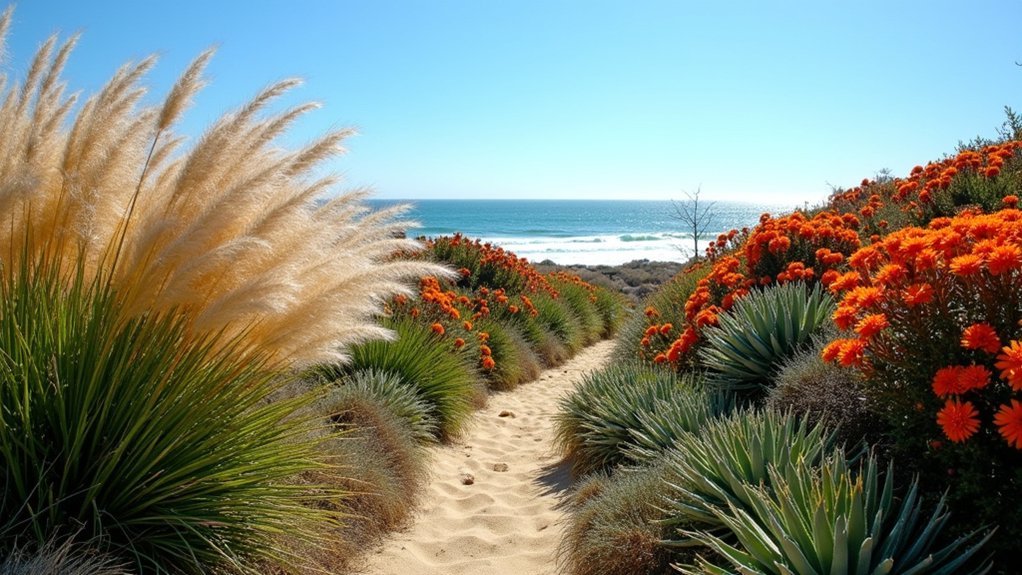
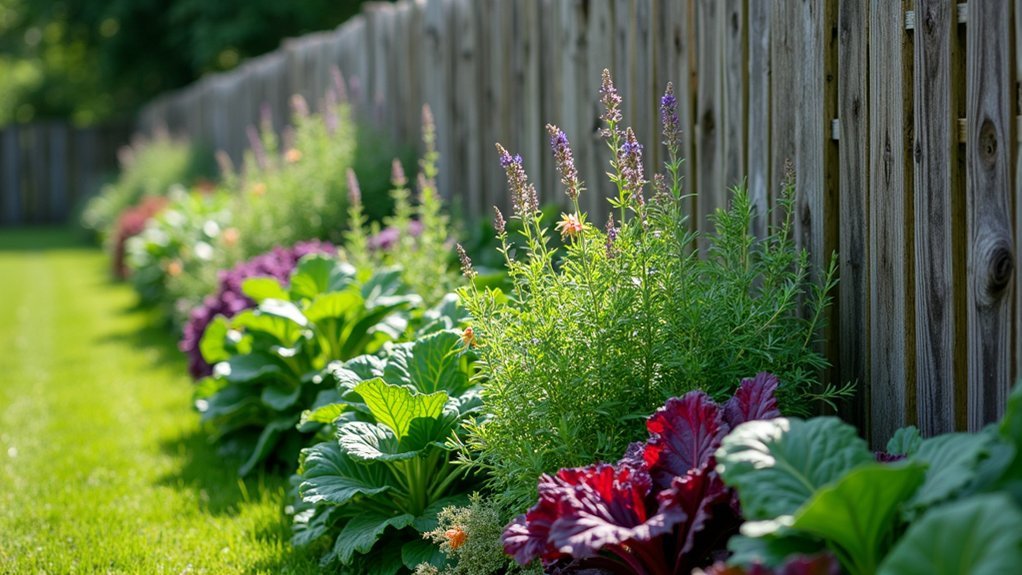
Leave a Reply